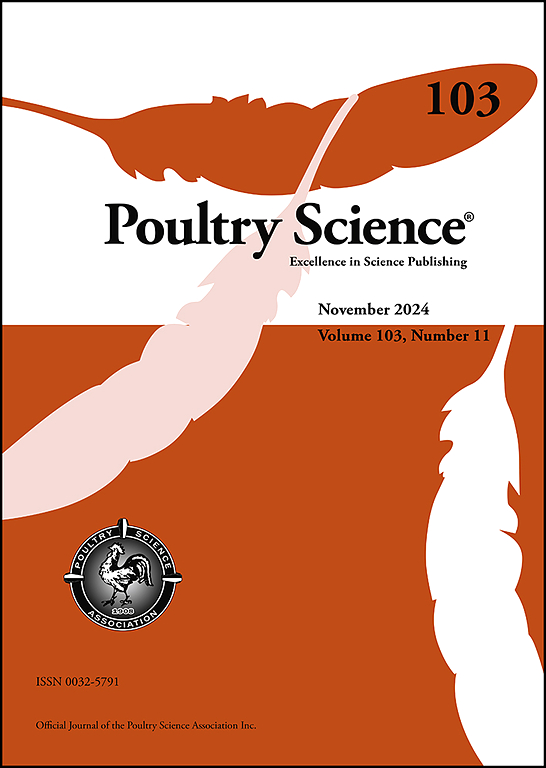Strengths, challenges, and variations - insights into biosecurity practices in Swedish poultry production following HPAI outbreaks
IF 4.2
1区 农林科学
Q1 AGRICULTURE, DAIRY & ANIMAL SCIENCE
引用次数: 0
Abstract
This study investigated quantitatively and qualitatively the implementation of biosecurity in commercial poultry production in Sweden during 2020 and 2021 when outbreaks of highly pathogenic avian influenza (HPAI) occurred. The study included case and non-case farms located in areas subjected to HPAI restriction zones with broiler parent breeders, layer pullets, laying hens, broilers, and meat turkeys with at least 2,000 birds. General biosecurity routines were investigated focusing on the wild bird-poultry interface. Data collection was based on face-to-face interviews and on-farm observations on 15 farms with HPAI outbreaks and 33 matched non-case farms using a questionnaire and the biosecurity scoring tool Biocheck.UGent (https://biocheckgent.com) to assess general biosecurity practices. Data were analyzed to identify differences related to poultry categories, geographical region, farm size and HPAI disease status. Additionally, qualitative data were examined using thematic analysis to explore barriers to biosecurity implementation.
The findings indicated that while biosecurity levels were generally high, there was significant variation among farms with category-specific strengths and challenges. Common weaknesses observed included inadequate infrastructure such as anteroom layout, limited training of farmworkers, suboptimal hand hygiene, and difficulties in maintaining good hygiene during the storage and introduction of roughage, such as hay and straw, into barns. Moreover, farmyards often lacked designated clean and dirty areas.
The qualitative analysis identified several factors affecting the implementation of biosecurity, and key qualitative themes were conflicting priorities, compliance based on perceived risk, and feelings of powerlessness. A need for specific knowledge on effective biosecurity measures against HPAI was expressed as well as lack of knowledge among farmworkers. The farm infrastructure could both facilitate and hamper effective biosecurity depending on its design. A risk-based approach meant adapting biosecurity based on the perceived risk of outbreaks and risk connected to different introduction routes. The conflicts of interest raised were often in relation to animal welfare and environmental considerations.
The main conclusions were that there is high heterogeneity in biosecurity among Swedish poultry farms, with implementation affected by multiple factors.
优势、挑战和变化——高致病性禽流感爆发后瑞典家禽生产生物安全实践的见解
本研究定量和定性地调查了2020年和2021年高致病性禽流感(HPAI)爆发期间瑞典商业家禽生产中生物安全的实施情况。该研究包括位于受高致病性禽流感限制地区的病例和非病例农场,这些农场有肉鸡亲本饲养者、蛋鸡、蛋鸡、肉鸡和至少有2000只鸡的肉鸡。以野鸟-家禽界面为重点,对一般生物安全规程进行了调查。数据收集基于面对面访谈和对15个爆发高致病性禽流感的农场和33个匹配的无病例农场的现场观察,使用问卷调查和生物安全评分工具Biocheck。UGent (https://biocheckgent.com)评估一般生物安全做法。对数据进行分析,以确定与家禽类别、地理区域、养殖场规模和高致病性禽流感疾病状况有关的差异。此外,使用专题分析对定性数据进行了检查,以探索生物安全实施的障碍。研究结果表明,虽然生物安全水平普遍较高,但不同类别的农场之间存在显著差异,具有特定的优势和挑战。观察到的常见弱点包括基础设施不足,如接待室布局,农场工人培训有限,手部卫生不理想,以及在储存和将干草和稻草等粗饲料引入谷仓期间难以保持良好的卫生。此外,农家院往往缺乏指定的清洁和肮脏区域。定性分析确定了影响生物安全实施的几个因素,关键的定性主题是相互冲突的优先事项、基于感知风险的遵守以及无力感。与会者表示,需要掌握有效预防高致病性禽流感的生物安全措施的具体知识,以及农场工人缺乏相关知识。根据其设计,农场基础设施既可以促进也可以阻碍有效的生物安全。基于风险的方法意味着根据疫情的感知风险和与不同引入途径相关的风险调整生物安全。所提出的利益冲突往往与动物福利和环境考虑有关。主要结论是,瑞典家禽养殖场的生物安全存在高度异质性,其实施受到多种因素的影响。
本文章由计算机程序翻译,如有差异,请以英文原文为准。
求助全文
约1分钟内获得全文
求助全文
来源期刊

Poultry Science
农林科学-奶制品与动物科学
CiteScore
7.60
自引率
15.90%
发文量
0
审稿时长
94 days
期刊介绍:
First self-published in 1921, Poultry Science is an internationally renowned monthly journal, known as the authoritative source for a broad range of poultry information and high-caliber research. The journal plays a pivotal role in the dissemination of preeminent poultry-related knowledge across all disciplines. As of January 2020, Poultry Science will become an Open Access journal with no subscription charges, meaning authors who publish here can make their research immediately, permanently, and freely accessible worldwide while retaining copyright to their work. Papers submitted for publication after October 1, 2019 will be published as Open Access papers.
An international journal, Poultry Science publishes original papers, research notes, symposium papers, and reviews of basic science as applied to poultry. This authoritative source of poultry information is consistently ranked by ISI Impact Factor as one of the top 10 agriculture, dairy and animal science journals to deliver high-caliber research. Currently it is the highest-ranked (by Impact Factor and Eigenfactor) journal dedicated to publishing poultry research. Subject areas include breeding, genetics, education, production, management, environment, health, behavior, welfare, immunology, molecular biology, metabolism, nutrition, physiology, reproduction, processing, and products.
 求助内容:
求助内容: 应助结果提醒方式:
应助结果提醒方式:


